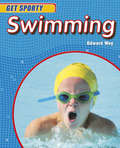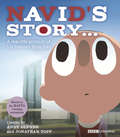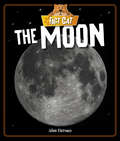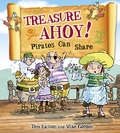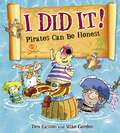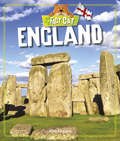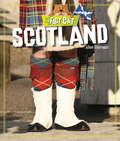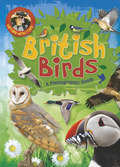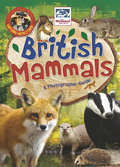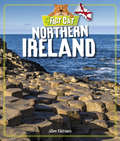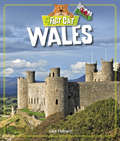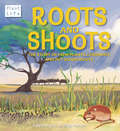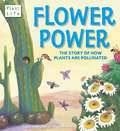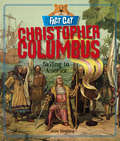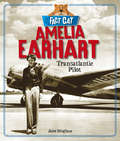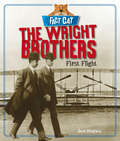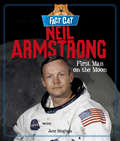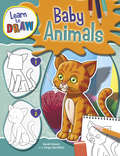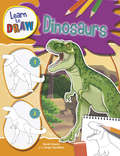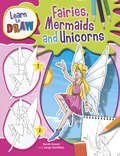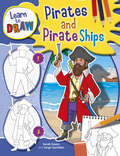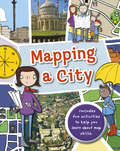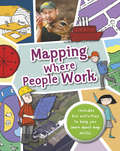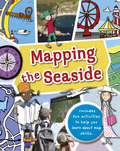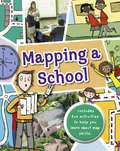- Table View
- List View
Swimming: Swimming (Get Sporty #3)
by Edward WayThis book tells you all you need to know to help you start swimming. Step-by-step photos will show you the strokes you'll need, there are top tips on improving your technique and pro play panels show top swimmers demonstrating their skills in competitions.
Navid's Story - A Journey from Iran: A Real-life Account Of His Journey From Iran (Seeking Refuge)
by Andy GlynneThis picture book tells the story of Kurdish Iranian refugee, Navid. When Navid was four years old his father was forced to flee Iran as there were threats on his life.Told in Navid's own words, the story highlights the terror and hardship that Navid and his mother suffered in their long journey to follow his father to a safe place, and the strange feelings that Navid had towards him when they were reunited.The BAFTA award-winning Seeking Refuge stories were originally produced as animations for the BBC. These powerful and evocative stories have now been captured in book form as rich, visual testimonies of the torment, hope and resolution of young refugees who are seeking asylum and adjusting to life in new countries all over the world.The series of five books form an excellent cross-curricular resource that looks at asylum, war, separation and integration and what it is to be a refugee today making them ideal for tying into Refugee Week.
Moon: Space: Moon (Fact Cat: Countries #3)
by Alice HarmanRead all about the Moon, what it's made of, its orbit, the first men on the Moon, getting to the Moon and how the Moon affects the Earth.Simple quiz questions at the back help readers to remember what they've just read.
Treasure Ahoy! Pirates Can Share: Pirates Can Share (Pirates to the Rescue #2)
by Tom Easton (Author)Bad luck hits the ship, the 'Golden Duck' when, during a storm, the captain's wooden leg is broken, Polly Parrot is hit by lightning and loses all her feathers and Nell loses her only bandanna.While they are anchored by a small island for repairs, Sam goes ashore to find supplies. He finds a bag of coins which he keeps secret from everyone else. When they set sail again, he is torn between wanting to buy things for himself or wanting to buy things for his friends. When they reach the mainland shops, what will Sam choose to do?The books in the 'Pirates to the Rescue' series are designed to help children to recognise the virtues of generosity, honesty, politeness and kindness. Reading these books with children will help them to understand that their actions and behaviour have a real effect on people around them. The books will help young readers to recognise what is right and wrong and what to do when faced with difficult choices.Notes for parents, guardians and teachers are included at the end of the story to help give starting points for discussion and follow-up activities to help encourage positive behaviour.
I Did It!: Pirates Can Be Honest (Pirates to the Rescue #3)
by Tom Easton (Author)Captain Cod asks Davy to be careful moving cannonballs about, but poor Davy ignores him and ends up dropping a heavy cannonball through a hatch where it goes right through the keel causing a leak. Davy is so embarrassed he shuts the hatch and goes to bed. The next morning, he wakes up to find the bottom of the boat is full of water. He decides it's time he owns up and bravely goes to see the captain. But will it be too late to save the ship? Will Davy get into trouble for not be honest in the first place?The books in the 'Pirates to the Rescue' series are designed to help children to recognise the virtues of generosity, honesty, politeness and kindness. Reading these books with children will help them to understand that their actions and behaviour have a real effect on people around them. The books will help young readers to recognise what is right and wrong and what to do when faced with difficult choices.Notes for parents, guardians and teachers are included at the end of the story to help give starting points for discussion and follow-up activities to help encourage positive behaviour.
England: United Kingdom: England (Fact Cat: Countries #1)
by Alice HarmanRead all about England, its location within the UK and Europe, its history, population, geographical features, landmarks, capital city, people and industry, coasts, towns and countryside areas.This series uses maps and atlases to look at the locations, geography and weather patterns.A simple fun picture quiz helps readers to recall what they have read.A perfect one-stop-shop for help with homework assignments!Key Stage 1 of the curriculum focuses on the study of Great Britain - an excellent classroom resource.Broad-ranging appeal for nursery age through to Key Stage 2.
Scotland: United Kingdom: Scotland (Fact Cat: Countries #2)
by Alice HarmanRead all about Scotland, its location within the UK and Europe, its history, geographical features, landmarks, capital city, people and industry, coasts, town and countryside areas.The series uses maps and atlases to look at the locations, geography and weather patterns.A simple fun picture quiz helps readers to recall what they have read.A perfect one-stop-shop for help with homework assignments!Key Stage 1 of the curriculum focuses on the study of Great Britain - an excellent classroom resource.Broad-ranging appeal for nursery age through to Key Stage 2.
British Birds: British Birds (library Ebook) (Nature Detective #1)
by Victoria MunsonThis book introduces more than 50 of the most common birds found in Britain today. There are full descriptions of the birds, along with their scientific name, size, family and habitat. Full colour photographs will help with easy identification. Includes advice on how to be a good birdwatcher, such as best places to see birds and how to take notes to aid recognition, and tips on how to attract birds to your garden or local area. Find out how to make bird food to help birds survive the winter.Birds featured: Barn Owl, Black-headed Gull, Blackbird, Blackcap, Blue Tit, Bullfinch, Buzzard, Canada Goose, Carrion Crow, Chaffinch, Coal Tit, Collared Dove, Common Gull, Coot, Cormorant, Cuckoo, Dunnock, Feral Pigeon, Fieldfare, Goldfinch, Great Crested Grebe, Great Spotted Woodpecker, Great Tit, Green Woodpecker, Greenfinch, Grey Heron, Grey Partridge, Grey Wagtail, Greylag Goose, Herring Gull, House Martin, House Sparrow, Jackdaw, Jay, Kestrel, Kingfisher, Little Grebe, Long-tailed Tit, Magpie, Mallard, Mistle Thrush, Moorhen, Mute Swan, Nuthatch, Pheasant, Pied Wagtail, Pigeon, Pochard, Puffin, Raven, Red Kite, Redwing, Ring-necked Parakeet, Robin, Rook, Shag, Siskin, Song Thrush, Sparrowhawk, Starling, Swallow, Swift, Tawny Owl, Tree Sparrow, Tufted duck, White Wagtail, Woodpigeon, Wren.
British Mammals: British Mammals (library Ebook) (Nature Detective #2)
by Victoria MunsonThis book introduces 50 of the most common mammals found in Britain today. There are full descriptions of the scientific name, size, food and habitat of each animal. Full colour photographs will help with easy identification. Includes advice on how to be a good nature detective, such as best places to see these mammals and how to take notes to aid recognition. Activities at the end of the book show how to make animal homes and identify footprints.
Northern Ireland: United Kingdom: Northern Ireland (library Ebook) (Fact Cat: Countries #3)
by Alice HarmanRead all about Northern Ireland, its location within the UK and Europe, its history, geographical features, landmarks, capital city, people and industry, weather, coasts, towns and countryside areas.This series uses maps and atlases to look at the locations, geography and weather patterns.A simple fun picture quiz helps readers to recall what they have read.A perfect one-stop-shop for help with homework assignments!Key Stage 1 of the curriculum focuses on the study of Great Britain - an excellent classroom resource.Broad-ranging appeal for nursery age through to Key Stage 2.
Wales: United Kingdom: Wales (library Ebook) (Fact Cat: Countries #4)
by Alice HarmanRead all about Wales, its location within the UK and Europe, its history, geographical features, weather, landmarks, capital city, people and industry, coasts, towns and countryside areas.This series uses maps and atlases to look at the locations, geography and weather patterns.A simple fun picture quiz helps readers to recall what they have read.Key Stage 1 of the curriculum focuses on the study of Great Britain - an excellent classroom resource.Broad-ranging appeal for nursery age through to Key Stage 2.
Roots and Shoots: Roots And Shoots (Plant Life)
by Judith HeneghanThis series highlights the relationship betweem human need and plant life in both our local and global environments. Roots and Shoots looks at the amazing variety of plants around the world, and focuses on the ingenious ways in which plants germinate and put down roots to provide nourishment and stability as they grow from a seed into a mature plant, along with many other processes that keep the plant and human world connected. Told through a lyrical narrative, this book contains specially commissioned illustrations that bring the plant world to life.
Flower Power: The Story of How Plants Are Pollinated (Plant Life)
by Judith HeneghanThis series highlights the relationship betweem human need and plant life in both our local and global environments. Flower Power looks at the amazing variety of plants around the world, and focuses on the ingenious ways in which plants transfer pollen from the male to the female parts, whether it's by the wind or with the help of creatures such as birds, bees and bats, along with many other processes that keep the plant and human world connected. Told through a lyrical narrative, this book contains specially commissioned illustrations that bring the plant world to life.
Christopher Columbus: History: Christopher Columbus (Fact Cat: History #1)
by Jane BinghamRead all about Christopher Columbus and his dream to sail to Asia. Follow his journey into the unknown, discover what he found in America and see what happened to him on his later voyages.A simple fun picture quiz helps readers to recall what they have read.A perfect one-stop-shop for help with homework assignments!Broad-ranging appeal for nursery age through to Key Stage 2.
Amelia Earhart: History: Amelia Earhart (Fact Cat: History #3)
by Jane BinghamRead all about Amelia Earhart, discover how she learnt to fly and find out about her record-breaking flights. Follow the progress of her final flight and explore the reasons why she disappeared.A simple fun picture quiz helps readers to recall what they have read.A perfect one-stop-shop for help with homework assignments!Broad-ranging appeal for nursery age through to Key Stage 2.
The Wright Brothers: History: The Wright Brothers (library Ebook) (Fact Cat: History #2)
by Jane BinghamRead all about the Wright Brothers, find out about their childhoods and follow their early tests and experiments. Learn all about the brothers' first flight and see how their invention changed the world.A simple fun picture quiz helps readers to recall what they have read.A perfect one-stop-shop for help with homework assignments!Broad-ranging appeal for nursery age through to Key Stage 2.
Neil Armstrong: History: Neil Armstrong (Fact Cat: History #4)
by Jane BinghamRead all about Neil Armstrong, discover how he became an astronaut and learn about the project to send men to the Moon. Follow the progress of the Apollo mission to the Moon and read about Armstrong's famous Moon walk.A simple fun picture quiz helps readers to recall what they have read.A perfect one-stop-shop for help with homework assignments!Broad-ranging appeal for nursery age through to Key Stage 2.
Learn to Draw Baby Animals: Baby Animals (Learn to Draw #6)
by Jorge SantillanLearn to Draw: Baby Animals shows children how to draw six adorable young animals, from puppies, kittens and bunnies to lambs, foals and chicks. Each drawing is broken down into seven simple, easy-to-follow steps to help children create, and then colour in, their own baby animal pictures. Fact boxes on each spread provide information about each baby animal, allowing children to learn about, as well as to draw, them. A glossary at the back of the book explains any complicated words, and a 'More Information' section gives suggestions as to how children can find out more about baby animals.If children have loved learning to draw baby animals, why not try learning to draw dinosaurs, dragons, fairies, mermaids, unicorns, knights, castles, pirates and pirate ships in other titles in the series?
Learn to Draw Dinosaurs: Dinosaurs (Learn to Draw #5)
by Jorge SantillanLearn to Draw: Dinosaurs shows children how to draw six incredible dinosaurs, from T-rex, Stegosaurus and Diplodocus to Triceratops, Velociraptor and Allosaurus. Each drawing is broken down into seven simple, easy-to-follow steps to help children create, and then colour in, their own dinosaur pictures. Fact boxes on each spread provide information about each dinosaur, allowing children to learn about, as well as to draw, them. A glossary at the back of the book explains any complicated words, and a 'More Information' section gives suggestions as to how children can find out more about dinosaurs.If children have loved learning to draw dinosaurs, why not try learning to draw baby animals, dragons, fairies, mermaids, unicorns, knights, castles, pirates and pirate ships in other titles in the series?
Learn to Draw Fairies, Mermaids and Unicorns: Fairies Mermaids And Unicorns (Learn to Draw #4)
by Jorge SantillanLearn to Draw: Fairies shows children how to draw six incredible mythical creatures, from forest, water and fire fairies to mermaids and unicorns. Each drawing is broken down into seven simple, easy-to-follow steps to help children create, and then colour in, their own mythical creature pictures. Fact boxes on each spread provide information about each creature, allowing children to learn about, as well as to draw, them. A glossary at the back of the book explains any complicated words, and a 'More Information' section gives suggestions as to how children can find out more about myths and legends.If children have loved learning to draw mythical creatures, why not try learning to draw dinosaurs, dragons, baby animals, knights, castles, pirates and pirate ships in other titles in the series?
Learn to Draw Pirates: Pirates (Learn to Draw #3)
by Jorge SantillanLearn to Draw: Pirates shows children how to draw six piratical things, from pirate captains and peg-leg sailors to enormous pirate sailing ships. Each drawing is broken down into seven simple, easy-to-follow steps to help children create, and then colour in, their own pirate pictures. Fact boxes on each spread provide information about pirates, allowing children to learn about, as well as to draw, them. A glossary at the back of the book explains any complicated words, and a 'More Information' section gives suggestions as to how children can find out more about pirates.If children have loved learning to draw pirates, why not try learning to draw dinosaurs, dragons, fairies, mermaids, unicorns, knights, castles, baby animals in other titles in the series?
A City: A City (Mapping #4)
by Jen GreenFull of hands-on activities to help you learn all about map skills whilst also learning about the features of a city. This book will show you what a bird's eye map is by looking at aerial photos; how landmarkscan be shown as symbols; how to measure scale and distance on a walk around a city; what map plans are; how compass points show you how to find directions; how to follow pathways and roads; how to use grid references; looking at landuse ; and looking at transport maps.Illustrations by Sarah Horne in an amusing and lively style are combined with photographs to really capture a child's attention helping them to learn these important map skills.
Where People Work: Where People Work (Mapping #3)
by Jen GreenFull of hands-on activities to help you learn all about map skills whilst also learning about the features of a where people work. This book will show you what a bird's eye map is by looking at aerial photos; how landmarks can be shown as symbols; how to measure scale and distance; what map plans are; how compass points show you how to find directions; how to follow pathways and roads; how to use grid references; looking at landuse ; and looking at transport maps.Illustrations by Sarah Horne in an amusing and lively style are combined with photographs to really capture a child's attention helping them to learn these important map skills.
the Seaside: The Seaside (Mapping #6)
by Jen GreenFull of hands-on activities to help you learn all about map skills whilst also learning about the features of the seaside. This book will show you what a bird's eye map is by looking at aerial photos of a seaside town;how tourist maps can help you find your way around; how symbols are used to represent landmarks, how to use a compass at the beach; how scale works by comparing two different harbours; to make a plan map of a pier showing how it is used; using grid references on a holiday campsite; planning a walk near a river estuary using a map; showing contour lines to map cliffs; using weather maps and landuse maps to show seaside buildings such as shops, hotels and houses; looking at islands and how teh water around them is mapped.Illustrations by Sarah Horne in an amusing and lively style are combined with photographs to really capture a child's attention helping them to learn these important map skills.
A School: A School (Mapping #2)
by Jen GreenFull of hands-on activities to help you learn all about map skills whilst also learning about the features of a school. This book will show you what a bird's eye map is by looking at aerial photos of a school; how symbols make a map clearer; how compass points can help you find your way around a school; how a plan map shows features of a classroom such as shelves, desks, tables and cupboards; how scale is used to measure a school or a school hall; how to use compass points in the playground; how land use maps work by mapping the rooms in the building; how to use grid references to find classrooms in a school; how to use street maps to find your way from home to school or use transport maps to get to school by bus or further afield on a school trip.Illustrations by Sarah Horne in an amusing and lively style are combined with photographs to really capture a child's attention helping them to learn these important map skills.
